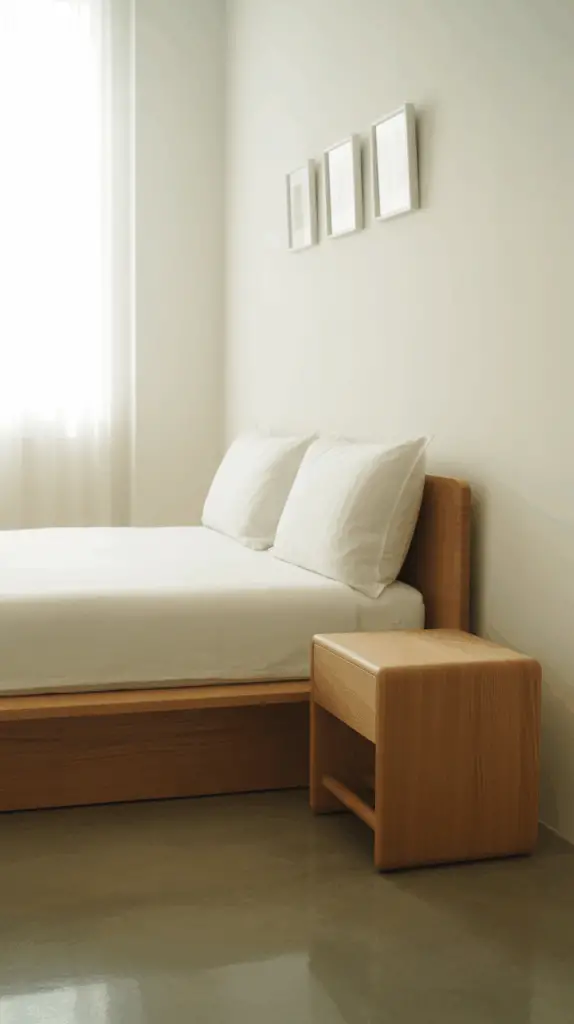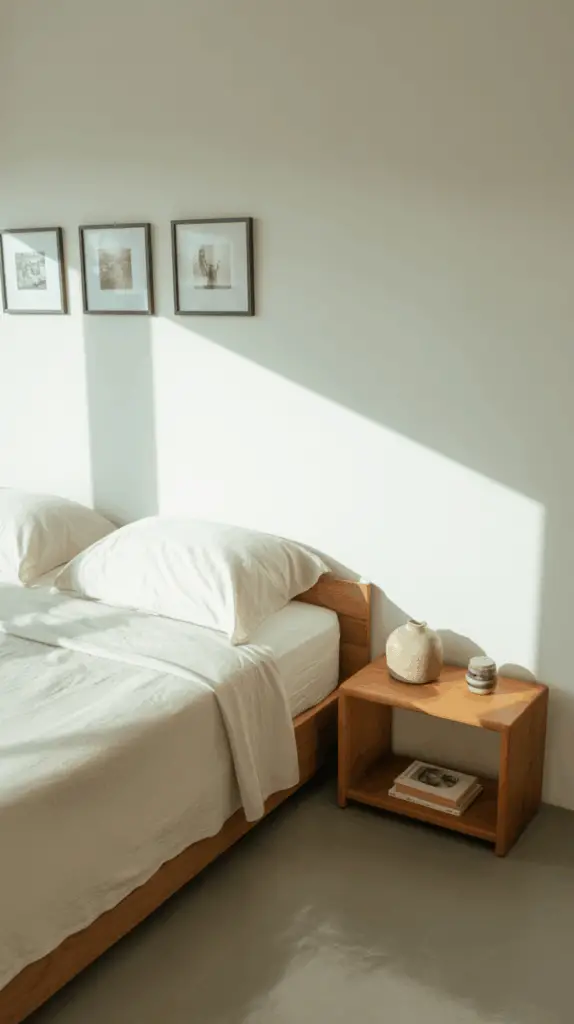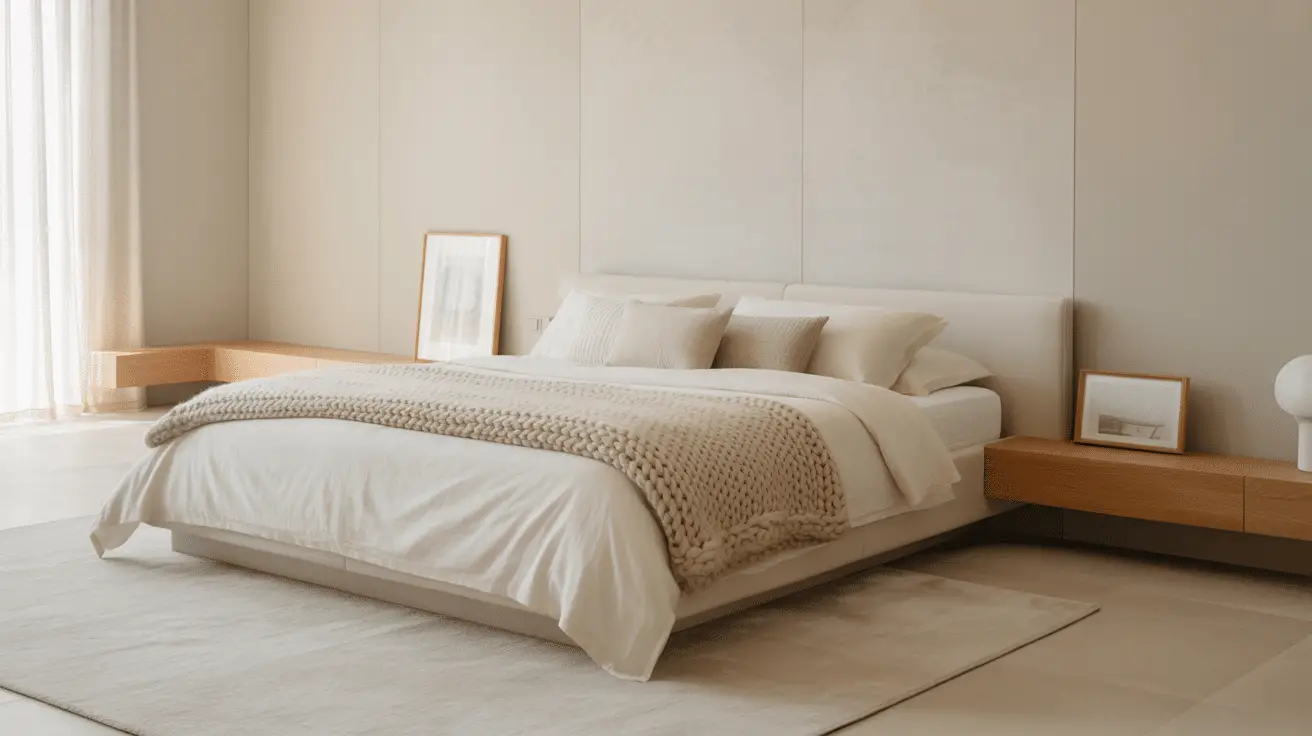Embrace a Minimalist Bedroom Style for a Fresh Look: Transform Your Space with Simple Elegance
Table of Contents
Introduction
In today’s fast-paced world, the cluttered chaos of everyday life can seep into our personal spaces, leaving us feeling overwhelmed and stressed. But what if your bedroom could become a haven of peace, a place where simplicity reigns and tranquility thrives? Minimalist bedroom design offers a solution to the chaos, allowing you to create a calming, organized, and stylish retreat.
Minimalism is not just about reducing the number of items in a room; it’s about focusing on what truly matters and eliminating distractions. This approach has gained immense popularity in interior design, particularly in the bedroom, where we seek rest and relaxation. With just a few thoughtful changes, you can transform your bedroom into a serene oasis that feels both fresh and rejuvenating.
In this blog post, we will guide you through the principles of minimalist bedroom design. You’ll discover how to embrace simplicity through smart furniture choices, color palettes, lighting, and layout. From decluttering to selecting the right decor, we’ll explore how to create a space that not only looks beautiful but also enhances your well-being. Let’s dive into the world of minimalist bedroom style and unlock its potential for a fresh, peaceful retreat.
Choosing a Minimalist Color Palette for Your Bedroom
A key element in achieving a minimalist bedroom design is selecting the right color palette. The colors you choose will set the tone for the entire room, creating a calm and serene atmosphere. Neutral tones are the backbone of minimalist design, but incorporating subtle contrasts can add depth and interest without overwhelming the senses.
Neutral shades like whites, greys, beiges, and soft taupes create a clean, refreshing canvas. These colors allow the space to feel open and airy, promoting relaxation and restfulness. To enhance the minimalist vibe, you can add pops of soft colors like muted pastels or earthy tones, such as sage green or light blush, which blend seamlessly with the neutral base.
Consider how natural light will play into your room’s ambiance. If your bedroom gets plenty of natural light, cool tones like light greys and whites will help balance the warmth from the sun. On the other hand, if the room lacks natural light, warmer shades like soft creams or beige can make the space feel cozier and more inviting.
Decluttering: The Foundation of Minimalist Bedroom Design
Decluttering is the cornerstone of minimalist design. A clean and organized space is essential for creating a serene environment. The first step in embracing a minimalist bedroom is to remove unnecessary items that don’t serve a functional or aesthetic purpose.
Start by assessing each item in your bedroom: ask yourself whether it adds value or simply contributes to visual clutter. Consider the functionality of each piece of furniture, decor, and accessory. A minimalist bedroom should only contain items that you truly love and use. This could mean parting with excess furniture, decorative objects, or even sentimental items that no longer align with your vision for the space.
To help you declutter, follow these practical steps:
- Begin with the bed: Make sure it’s the focal point of the room, not buried under unnecessary pillows or blankets.
- Tidy up surfaces: Remove items from nightstands, dressers, and other surfaces that don’t have a designated purpose.
- Limit decor: Choose one or two statement pieces for the walls or shelves, instead of overcrowding the room with decor.
The result will be a cleaner, more open space that allows you to breathe easier and focus on what truly matters.

Smart Furniture Choices for a Minimalist Bedroom
When designing a minimalist bedroom, the furniture you choose plays a crucial role in the overall feel of the space. Since minimalist design focuses on simplicity and functionality, opt for pieces that are sleek, unembellished, and multi-functional.
Look for furniture that combines both form and function. A low-profile bed with a clean design, such as a platform bed, works well in minimalist spaces. Avoid heavy, ornate furniture, as it can make the room feel crowded. Instead, choose pieces with clean lines and neutral colors that blend seamlessly with the rest of the room.
Storage is an essential consideration. In a minimalist bedroom, keeping things organized is key to avoiding clutter. Consider furniture with hidden storage solutions, such as ottomans with built-in compartments or a bed with drawers underneath. This will help you keep everyday essentials out of sight, preserving the clean aesthetic of your space.
Lastly, furniture made of natural materials like wood, metal, or linen complements the minimalist aesthetic. These materials add warmth and texture while maintaining the simplicity that defines the style.

Lighting: Setting the Mood with Minimalist Fixtures
Lighting is an integral part of any room’s design, and in a minimalist bedroom, it can truly elevate the space. Minimalist lighting fixtures are typically simple, unobtrusive, and stylish. The goal is to create a soothing atmosphere while maintaining the clean lines and serene ambiance of the space.
Start with layered lighting. This includes ambient lighting, task lighting, and accent lighting. A statement pendant light or a sleek ceiling fixture provides the overall ambient light. For task lighting, opt for minimalistic table lamps or wall sconces beside the bed. Accent lighting, such as LED strips or small accent lamps, can highlight specific features of the room, like artwork or plants.
Another important aspect is the natural light that enters the room. The more natural light you can bring into your bedroom, the better. Large windows with simple curtains or blinds will help your room feel more open and connected to the outside world.
Consider energy-efficient lighting options, such as LED bulbs, which not only save energy but also produce a softer, warmer glow that complements minimalist decor.
Texture and Material Choices to Add Warmth and Depth
In minimalist bedroom design, texture and materials play a significant role in making the space feel cozy and inviting without sacrificing simplicity. While minimalism often involves neutral colors and clean lines, adding texture can create visual interest and warmth.
Start with your bedding. Opt for soft, natural fabrics like linen or cotton for your duvet cover and sheets. A chunky knit throw or a textured wool blanket can add layers of comfort while staying true to the minimalist aesthetic. Choose a duvet or comforter in a solid, neutral color to keep the look understated.
When selecting flooring, consider natural wood, bamboo, or stone tiles, which add a tactile element to the room without overwhelming the space. Soft rugs made from natural fibers like wool or jute can further enhance the room’s coziness, adding texture while maintaining the minimalist vibe.
Lastly, introduce a few plants to bring life and vibrancy into the room. Opt for low-maintenance greenery like succulents, snake plants, or peace lilies. These plants not only improve air quality but also add a natural, organic touch to your minimalist space.
How to Organize Your Minimalist Bedroom for Maximum Functionality
Functionality is just as important as aesthetics when it comes to minimalist bedroom design. A well-organized room contributes to a sense of calm and order. In a minimalist space, every item should have a designated place, and every piece of furniture should serve a purpose.
Begin by assessing your storage needs. In a minimalist bedroom, built-in storage solutions can help eliminate visual clutter. Consider installing floating shelves, a wall-mounted nightstand, or a storage bench at the foot of the bed. These solutions keep everyday items easily accessible while maintaining a clean, streamlined look.
Use multi-functional furniture to maximize space. For example, a bedside table with built-in drawers or a bed with an adjustable headboard can make the most of every square inch. Consider minimalist shelving units that are both functional and visually appealing, providing a place for books, decorative pieces, or plants.
Lastly, declutter your closet and storage areas. A minimalist bedroom doesn’t just look tidy—it stays tidy. Invest in storage bins, baskets, and organizational tools that keep clothing, accessories, and personal items neatly stored out of sight.
Conclusion
Embracing a minimalist bedroom style is more than just a design choice; it’s a way of living. By simplifying your space, you not only create a room that’s visually pleasing but also one that fosters calm, focus, and relaxation. Whether it’s choosing the right color palette, decluttering, or selecting functional furniture, every detail plays a role in creating a harmonious environment.
With the tips shared in this guide, you can transform your bedroom into a serene sanctuary. The beauty of minimalist design lies in its simplicity—by removing excess and focusing on what truly matters, you can create a peaceful retreat that refreshes both your space and your mind.

